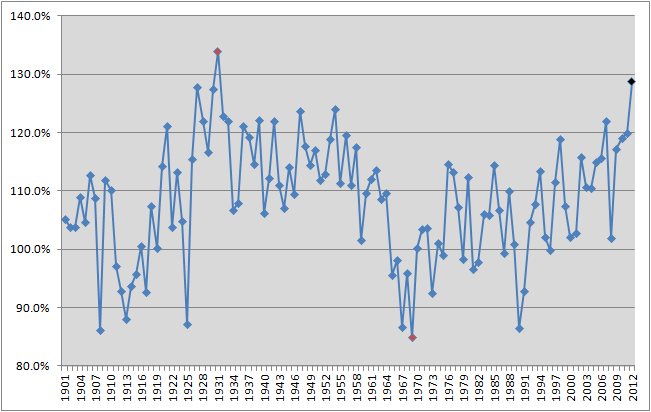The Yankees’ offense is a victim of high expectations. Whenever the team loses a game or two, it has become fashionable to blame the lineup’s inability to get the “big hit” and lament all of the men left on base. The more logical reaction would be to point a finger at the team’s underperforming rotation, which has compiled the second lowest quality start ratio in the major leagues and put the Yankees in a first inning hole of at least three runs on four occasions. But, that’s too easy. So, instead, fans fixate on the offense’s inability to get the one hit needed to finish off a big comeback.
How good has the Yankees’ offense been over the first month of the 2012 season? Well, for starters, the team’s 5.62 runs scored per game is the best in the major leagues. And, as if that wasn’t sufficiently impressive, the 128.7% premium over the American League average of 4.37 runs per game represents the second highest comparative advantage in franchise history. Only the 1931 Bronx Bombers, who were led by Babe Ruth and Lou Gehrig, managed to out score the American League by a wider margin.
Historical Comparison of Yankees R/G vs. League Average (click to enlarge)

Note: Graphs represents the percentage by which the team over-performed or underperformed the average (100% on the x-axis).
Source: Baseball-reference.com
Despite this compelling evidence, there will undoubtedly still be some Yankees’ fans who remain unconvinced about the prowess of the team’s offense. One of the typical rebuttals centers on the lineup’s inconsistency. Arguments built on that premise suggest that the offense scores in bunches, but over the first 21 games, the Yankees have tallied at least five runs on 16 occasions (including four losses).
Another common complaint about the Yankees’ offense is that even though they score a lot of runs, they are inefficient when it comes to hitting with runners in scoring position. However, that’s also untrue. In 236 plate appearances with at least a man on second base, the team has hit .277/.362/.456, which, in terms of OPS, is 27% better than the league average. Although there are some splits, like men on third and less than two outs, in which the lineup has under-performed, it’s worth noting that its BABIPs are extraordinarily low (.189 in this example). Meanwhile, the success rate on balls in play is much more in line with norms for splits in which the offense has excelled. So, if anything, the peripherals reveal that the offense may be even better than the total output suggests. Anecdotally, the same argument could also be made just by looking at the performance of Robinson Cano and Mark Teixeira, who have posted an OPS+ of 90 and 75, respectively, while batting in the middle of the order.
Considering how poorly their starting pitchers have performed, some might say the Yankees should probably consider themselves lucky to be 12-9. However, good fortune has very little to do with the team’s record. Over the first month, the Yankees have managed to play respectably because of their potent offense and shutdown bullpen, but for how long can those two components of the team compensate for such a poor showing from the starters? It’s much too early to play the blame game, but if one feels the need, the starting rotation is really the only place to look because, at least in April, the offense has been beyond reproach.

[…] getting off to a historic start in April, the Yankees offense has hit the skids in May. As a result, the team’s output per game has […]